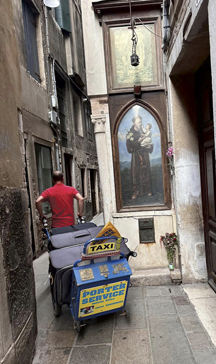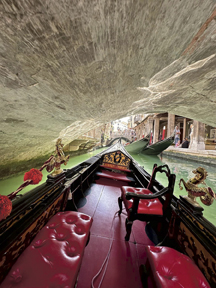
A Dream Called Venice

As our plane touched down at Marco Polo International Airport on that early May afternoon, the sun still clung to Venice, casting a warm glow over the city. We were finally here, about to experience the eternal city for the first time. A sleek water taxi awaited us, ready to whisk us away to our home base, the Royal Hotel San Marco, located on one of the world’s most famous historic squares. The walk from the dock through the Piazza San Marco to the hotel would have been treacherous with our luggage, so we hired a porter at the dock. As we soaked in the surroundings, our reward lay just beyond the corner: the Piazza San Marco, the pulsing heart of Venice, with its Byzantine domes and vibrant tapestry of history. Shortly, we followed our skilled porter over a small bridge to the hotel. After paying him the 25 Euros that he’d advertised, he was on his merry way back to the dock.
The Royal Hotel San Marco proved a comfortable haven. Our suite offered a stunning view of the canal, with gondolas gliding past our bedroom windows. The breakfast buffet, while not lavish, provided a satisfying start to our days. But it was the hotel’s prime location, steps from the iconic square, that truly shone. The nearby Piazza San Marco drew us in, its energy infectious. We wandered the labyrinthine streets, discovering mask shops, cozy cafes, and boutiques showcasing Murano glass. History seemed to seep from every stone, every ornate bridge, inviting exploration. Venice was everything we had imagined and then some.
 Our tour guide, Marie-Therese, brought the Doge’s Palace to life the next morning. Her stories of the Venetian Republic’s power and influence had us spellbound. The palace, with its sun-drenched facade and delicate arches, stood as a testament to the city’s enduring legacy. The Doge’s Palace, or Palazzo Ducale, was the seat of power of one of the world’s most powerful city-states, as the Venetian Republic dominated the Mediterranean for centuries. The Horses of Saint Mark, also known as the Triumphal Quadriga or Horses of the Hippodrome of Constantinople, is a set of bronze statues of four horses,
Our tour guide, Marie-Therese, brought the Doge’s Palace to life the next morning. Her stories of the Venetian Republic’s power and influence had us spellbound. The palace, with its sun-drenched facade and delicate arches, stood as a testament to the city’s enduring legacy. The Doge’s Palace, or Palazzo Ducale, was the seat of power of one of the world’s most powerful city-states, as the Venetian Republic dominated the Mediterranean for centuries. The Horses of Saint Mark, also known as the Triumphal Quadriga or Horses of the Hippodrome of Constantinople, is a set of bronze statues of four horses,  originally part of a monument depicting a quadriga. The horses were placed on the facade of St Mark’s Basilica after the sack of Constantinople in 1204. They remained there until looted by Napoleon in 1797 but were returned in 1815. Now the sculptures have been removed from the facade and placed in the interior of St Mark’s museum for conservation purposes, with replicas in their position on the loggia instead.
originally part of a monument depicting a quadriga. The horses were placed on the facade of St Mark’s Basilica after the sack of Constantinople in 1204. They remained there until looted by Napoleon in 1797 but were returned in 1815. Now the sculptures have been removed from the facade and placed in the interior of St Mark’s museum for conservation purposes, with replicas in their position on the loggia instead.
The day’s magic only intensified as we made our way by boat to Murano Island, a mecca for glass enthusiasts. In a studio filled with molten beauty, we witnessed a master at work, his hands shaping a fiery blob into a majestic little horse. The artistry, the precision, left us awestruck – a once-in-a-lifetime experience for any collector. As we sailed back to San Marco, the setting sun casting a golden glow over the lagoon, the day seemed almost too perfect. After freshening up at the hotel, we made our way into one of the side streets to find a place for dinner and maybe some gelato later for dessert.
The following morning, Mother’s Day, brought its own special brand of enchantment. An 8:30 am mass at the Basilica di San Marco, its mosaics shimmering like a celestial tapestry, set the tone for a day of celebration. With our sons unable to join us, my husband took it upon himself to make the day unforgettable. It was Ascension Day (“Sensa” in Venetian dialect). During the times of the Serenissima, the Doge would board the Bucintoro state galley and symbolically go and “marry” the Adriatic Sea by tossing a golden ring into its waters. The tradition continues unto the present days with the Venetian mayor marrying the Sea aboard a “bissona”, a traditional boat, escorted by all the rowing schools of Venice, and we got to witness it all by the waterfront.
 In the very heart of the square, surrounded by orchestral melodies and the gentle rustle of pigeons, we indulged later in tea and delicate pastries. The crew of waiters, one more handsome than the next, was rushing to please. The music, the setting, the sense of being at the world’s center – it all combined to create a Mother’s Day I would treasure forever. But the grand finale awaited. As the sun began its lazy descent into the Adriatic, we boarded a bright red gondola, its black hull gliding silently through the canals. The city took on a new dimension from the water – hidden gardens spilled with blooming flowers, ornate bridges spanned the glistening waterways, and the fading light danced across centuries-old facades. As we drifted past St. Mark’s Square, the basilica’s Byzantine beauty bathed in the golden light of sunset. I felt a sense of pure contentment wash over me. This, I knew, was the essence of Venice – a city where history and beauty intertwine, where every moment holds the promise of magic.
In the very heart of the square, surrounded by orchestral melodies and the gentle rustle of pigeons, we indulged later in tea and delicate pastries. The crew of waiters, one more handsome than the next, was rushing to please. The music, the setting, the sense of being at the world’s center – it all combined to create a Mother’s Day I would treasure forever. But the grand finale awaited. As the sun began its lazy descent into the Adriatic, we boarded a bright red gondola, its black hull gliding silently through the canals. The city took on a new dimension from the water – hidden gardens spilled with blooming flowers, ornate bridges spanned the glistening waterways, and the fading light danced across centuries-old facades. As we drifted past St. Mark’s Square, the basilica’s Byzantine beauty bathed in the golden light of sunset. I felt a sense of pure contentment wash over me. This, I knew, was the essence of Venice – a city where history and beauty intertwine, where every moment holds the promise of magic.
 The next morning, finally the Bridge of Sighs! It is approximately thirty-six feet long, made of white marble, and decorated with twenty masked heads, and is probably the most famous of the 400 bridges that all cross Venice’s hundred and fifty canals. Anyone visiting La Serenissima must see the legendary landmark. The Bridge of Sighs was the direct link between the notorious lead chambers and the new prisons. After the accused had been tried in the courtrooms of the Doge’s Palace, they were taken to the dungeons or even to their place of execution amidst avoidably heart-rending sighs. Of course Venice’s fine citizens could not be confronted with the direct sight of the pitiful creatures, so the walls of the closed construction served as an effective screen. Moreover, the walls on the bridge were beautifully decorated, as can be seen on the one hand from the “straw bridge” Ponte della Paglia or on the other hand from the Ponte della Canonica. Inside the Bridge of Sighs, two separate paths run to prevent eye contact between passers-by: One path for those not yet condemned and the second path for the delinquents who ended up in the dungeons or arrived in the part of the building added in 1589 where they were executed. They sighed in pain when they caught a last glimpse of the canal through the narrow peepholes.
The next morning, finally the Bridge of Sighs! It is approximately thirty-six feet long, made of white marble, and decorated with twenty masked heads, and is probably the most famous of the 400 bridges that all cross Venice’s hundred and fifty canals. Anyone visiting La Serenissima must see the legendary landmark. The Bridge of Sighs was the direct link between the notorious lead chambers and the new prisons. After the accused had been tried in the courtrooms of the Doge’s Palace, they were taken to the dungeons or even to their place of execution amidst avoidably heart-rending sighs. Of course Venice’s fine citizens could not be confronted with the direct sight of the pitiful creatures, so the walls of the closed construction served as an effective screen. Moreover, the walls on the bridge were beautifully decorated, as can be seen on the one hand from the “straw bridge” Ponte della Paglia or on the other hand from the Ponte della Canonica. Inside the Bridge of Sighs, two separate paths run to prevent eye contact between passers-by: One path for those not yet condemned and the second path for the delinquents who ended up in the dungeons or arrived in the part of the building added in 1589 where they were executed. They sighed in pain when they caught a last glimpse of the canal through the narrow peepholes.

 This was Venice – a city where history and beauty intertwine, where every moment holds magic. Venice has a distinguished culinary history, much of it based on its unique geographical position on the Adriatic Sea and, to a lesser degree, its cosmopolitan past as the hub of a trading empire. Venetian trading posts in the Levant gave the city access to exotic spices such as ginger, nutmeg, saffron, cloves, etc. which made their way into the local diet. Due to the later conquests of Venice from the end of the 18th century, these exotic ingredients are enriched with a dash of French or Austrian cuisine. In a city where the streets are made of water, seafood definitely dominates the menu, and then there’s Pizza and pasta and Gelato, and then some.
This was Venice – a city where history and beauty intertwine, where every moment holds magic. Venice has a distinguished culinary history, much of it based on its unique geographical position on the Adriatic Sea and, to a lesser degree, its cosmopolitan past as the hub of a trading empire. Venetian trading posts in the Levant gave the city access to exotic spices such as ginger, nutmeg, saffron, cloves, etc. which made their way into the local diet. Due to the later conquests of Venice from the end of the 18th century, these exotic ingredients are enriched with a dash of French or Austrian cuisine. In a city where the streets are made of water, seafood definitely dominates the menu, and then there’s Pizza and pasta and Gelato, and then some.
Our days in Venice were a tapestry of history and discovery – the Piazza San Marco, the Doge’s Palace, the mesmerizing artistry of Murano glass. But it was the quiet moments, the gondola ride, the Mother’s Day tea, that would stay with me forever.
Until next month from another interesting location.
— Yours in travel, Ingrid
Escape From Paradise: www.EscapeFromParadise.net
www.facebook.com/ingrid.lemme #EscapeFromParadise
Award-winning TV Host, Publisher, Travel Writer.
Ambassador for www.Seven-Stars.com & 15 Emmy awards www.aTasteofHistory.org
www.twitter.com/LemmeEscape www.instagram.com/ingridlemme

